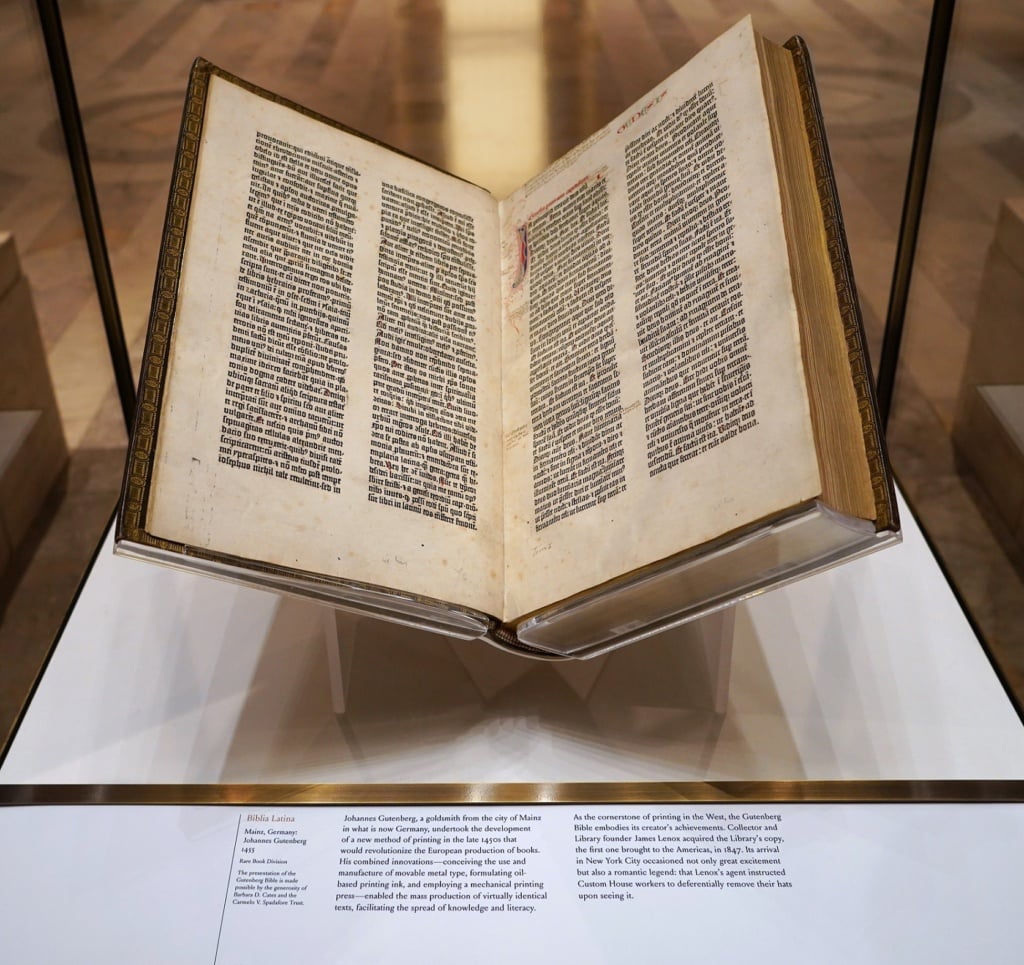Table of Contents
Who was Johannes Gutenberg?
When we think of the printing revolution and the subsequent spread of knowledge around the world, one name stands out from the rest: Johannes Gutenberg. He was not only an inventor, but a visionary who, through his determination and ingenuity, radically transformed the way in which information was shared, making knowledge accessible to the many rather than just an élite few.
Gutenberg’s life story
Born between 1394 and 1399 in Mainz, in what is today Germany, Johannes Gensfleisch zur Laden zum Gutenberg, better known as Johannes Gutenberg, belonged to a wealthy upper-class family of merchants. But little is known about his childhood and adolescence.
He is principally remembered for his invention: moveable type printing. This innovative system, which combined type made from a lead, tin and antimony alloy with the use of a special ink, enabled the mass production of books, drastically lowering costs and production times.
Gutenberg died in 1468, but his legacy lives on. His printing innovations paved the way for the information age, radically changing first European society, then the whole world.
A life spent between Mainz and Strasbourg
Gutenberg spent most of his life in the cities of Mainz and Strasbourg. In the 1430s, his family was forced to move to Strasbourg due to political unrest. There, Gutenberg dabbled in a number of different businesses and began his first experiments in printing.
In Strasbourg, Gutenberg quickly integrated himself into city life, putting together a group of investors to develop his printing technology. The city became a laboratory for his experiments, the place where he perfected a process that would change the world.

Gutenberg’s workshop in Mainz
In 1448, Gutenberg returned to Mainz, where he set up a workshop that would become the crucible for his printing work. Gutenberg had a clear goal: he wanted to create high-quality books in large quantities.
In this workshop, Gutenberg and his employees produced what is considered to be the first book printed with moveable type technology: the so-called Gutenberg Bible. Comprising over 1,200 pages and printed in around 180 copies, it’s a milestone in the history of printing and literature.
Gutenberg is expropriated by his business partner
Despite his brilliant innovations, Gutenberg faced several challenges. The biggest came when one of his biggest backers, Johann Fust, took him to court in 1455, claiming that Gutenberg hadn’t repaid a loan. The matter was resolved in favour of Fust, who took control of Gutenberg’s workshop and his precious inventions.
It was a severe blow to Gutenberg, who saw his dream slip through his hands. But despite this, he continued working and innovating, albeit on a smaller scale than before.
Gutenberg’s financial difficulties
After losing his workshop, Gutenberg was plunged into serious financial difficulties. Despite the revolutionary nature of his invention, a lack of patents or copyright meant that he couldn’t fully reap the rewards. Other entrepreneurs and printers copied and spread his technology, leaving Gutenberg as just one of many players in a rapidly growing market.
Gutenberg spent his final years in relative obscurity, supported financially by the archbishop of Mainz, who paid him a small stipend in recognition of his achievements. He died in 1468, not as a rich and powerful man, but as someone whose invention would help enlighten humanity for centuries to come.

Gutenberg’s moveable type printing: how it worked and how it’s been perfected over the years
Behind Gutenberg’s moveable type printing lies an ingenious mechanism and a series of innovations without which this revolution would not have been possible. Let’s take a closer look at key features of this technology and how it has evolved over the years.
Type: The brilliance of moveable type printing lies in the ability to reuse characters. Gutenberg’s system used single pieces of metal, each representing a letter or punctuation mark. These characters could be assembled in any combination to form words and sentences, then disassembled and reused. This was completely revolutionary compared to handwriting and printing techniques used at the time, which involved engraving entire pages on wooden or metal plates.
Ink: The ink used by Gutenberg was another key innovation. Unlike the water-based inks used in Asian printing methods, Gutenberg developed an oil-based ink that adhered much better to metal type.
The press: The other crucial element of Gutenberg’s invention was the printing press, which was based on presses used for winemaking. This allowed uniform pressure to be exerted on the page, transferring ink from the moveable type to the sheet of paper below.
Evolution and refinement: While Gutenberg’s original invention was revolutionary, moveable type printing technology continued to be refined over the years. Metal type became more precise and durable, presses became more efficient, and ink became sharper. Then the 18th-century industrial revolution saw the mechanisation of printing presses, hugely increasing production speeds.
Towards the end of the 19th century, offset printing, a technique in which the image is transferred to a cylinder and then to paper, revolutionised printing once again, enabling the production of high-quality images at scale. This technology eventually led to the modern printing presses we know today.

Why was Gutenberg’s moveable type printing revolutionary?
Fully grasping the importance of Gutenberg’s moveable type printing requires an understanding of the historical and cultural context in which it was invented. Before its invention, books were copied by hand by scribes, often monks, in a long and laborious process. This made books extremely expensive and accessible only to a small elite.
But moveable type printing changed all this by offering the following advantages:
Production speed: The ability to produce identical copies, quickly, dramatically reduced the time it took to create a book. Instead of the months or years it took to copy a text by hand, moveable type printing could print hundreds of pages a day.
Lower costs: With production at scale, the cost per copy fell significantly. This made books accessible to a much wider audience, democratising knowledge in the process.
Standardisation: Moveable type printing ensured consistency. Each copy of a book was identical to the others, eliminating the errors that inevitably crept in with manual transcription.
Dissemination of knowledge: The ability to produce books in large quantities led to a wider spread of knowledge. This had a profound impact on culture, education and science, as ideas could now be shared more easily and quickly.
Gutenberg: how his invention compares to humanity’s other great technological innovations
While the wheel, penicillin or electricity are often cited among humanity’s greatest inventions, Gutenberg’s moveable type printing should also be considered among them.
The most compelling argument is the multiplier effect it had on knowledge and education. As Europe was entering the Renaissance, a period of renewed interest in the arts, science and philosophy, the ability to rapidly spread new ideas led to an explosion of creativity and discovery.
Just as the wheel transformed mobility and penicillin revolutionised medicine, moveable-type printing radically changed the way humanity shares, stores and accesses knowledge. It started the information age, blazing a trail for future inventions and discoveries. It also laid the foundations for freedom of the press and freedom of expression, which are the foundations of modern democratic societies.
Every invention has its own unique value, and moveable-type printing’s was to create a bridge between past, present and future, allowing ideas to travel through time and space like never before. And for this, Gutenberg and his invention deserve a special place in the history of humanity.

Gutenberg, the press and human progress
Johannes Gutenberg was not only the inventor of moveable-type printing, but a pioneer who laid the foundations for an information age in which knowledge would become accessible to all. His story shows us how vision, determination and ingenuity can transform the world, even in the face of immense challenges. Gutenberg’s moveable-type printing sparked a revolution that transformed the world of publishing and information sharing. His invention was the first in a series of innovations that constantly refined the art of printing, making knowledge increasingly accessible to all. It’s a journey that starts with Gutenberg’s individual metal letters and ends in modern high-speed printing presses. The history of modern printing, which took its first steps thanks to Gutenberg’s genius, is a testament to human ingenuity and determination to share and preserve knowledge.

